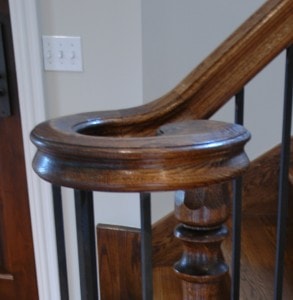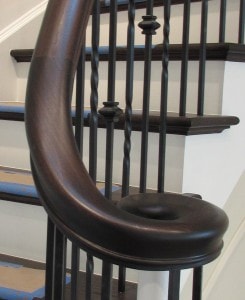A volute is that "Curly" piece that is at the start of many stair rails.

This photo shows a manufactured volute with a manufactured up ease fitting. The up ease fitting is the connector between the volute and rake rail.
A standard volute shape will have a rail fitting attached to it, called an "up easing". The up easing allows the rail that is coming down the rake of the stair to level out into the volute.
On many curved staircases, keeping the rail to a consistent height as it curves up the rake requires a special handmade volute called a "descending volute" or a "climbing volute".

The volute in this photo, is connected to the rake rail with a much longer and slightly twisting hand carved descending up ease fitting.
This type of a volute is a "hand carved fitting" that requires many hours of experienced layout skills to understand what is needed in each unique situation. The carving work on fittings can take anywhere from 4 hours to over 40 hours of experienced rail carving labor. The result is a beautiful, one of a kind piece that is unique to the stair that it was made for.
More and more we see descending volutes used on stairs that are not curved. They are desired for their strong artistic statement and elegant beauty. For more on carving rails, see Hand Carving Stair Railings.
Installing throughout the greater Chicago area; Selling anywhere in the world
Designed Stairs
Showroom (by appointment only), Shop, and Offices
1480 E Sixth Street
Sandwich IL 60548
815-786-7600